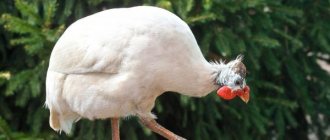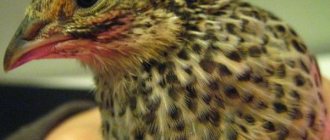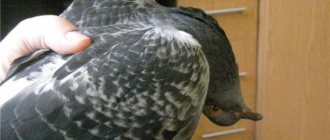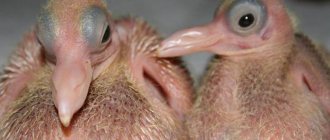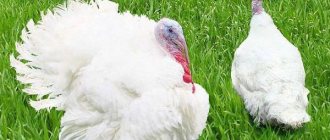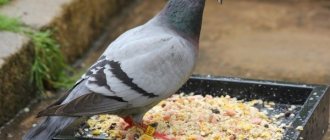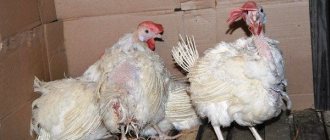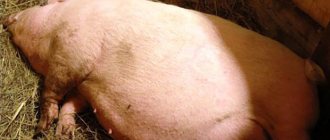How to distinguish between a dove and a dove
Domestic birds are different from wild birds. Some of the natural characteristics of gender are lost or changed. Although in some breeds the difference between males and doves is easier to notice.
By beak and head
“Boys” and “girls” are distinguished by appearance and behavior. Great importance is attached to the head and beak. First they pay attention to appearance, then they look at behavior.
Male pigeons are distinguished as follows:
- forehead higher;
- neck shorter and stronger:
- the head is larger;
- the beak and wax (where the nostrils are) are coarser and thicker.
Doves have different heads and beaks:
- The eyes are slightly larger in size and convex. Some people think they are more expressive.
- The head and beak are neater - smaller, thinner.
- The neck is slightly longer in relation to the body.
By color
The plumage of pigeons varies: from bluish to cherry, black. The color of females in nature is modest:
- dark, tending towards black;
- uniform gray.
Doves need to raise their chicks and protect them from predators, so females are most often inconspicuous. The task of males is to attract the attention of the opposite sex, so their coloring is lighter and brighter.
In domestic pigeons these features are often preserved. Males look smart:
- The color is more saturated, especially on the neck. There is also a noticeable metallic tint there.
- There are patterns on the tail, wings, and chest.
The breed brings its own characteristics:
- Some decorative pigeons cannot be distinguished by color. It's about the same.
- Other ornamental breeds have only minor features in their plumage. For example, in banded short-billed tumblers, this is the color of the tail. Male pigeons are distinguished by a wider white stripe. Check when the bird spreads its tail.
- There are breeds where it is convenient to distinguish males from females by the color of their plumage. For example, an adult male texan is white or yellowish with brown spots. The doves of this meat breed have dark plumage, combining shades of brown, gray, bluish, and lilac.
By bird size
If the male is healthy, he is usually larger than the dove:
- stronger, more massive body;
- noticeably heavier;
- legs are longer.
Although this is only a general rule. For some decorative breeds, everything is different:
- males sometimes look more fragile, doves are larger;
- the size is approximately the same.
Breeds are large, medium, small. For comparison, only representatives from the same “weight category” are taken. For example, the Astrakhan breed is larger than the Perm hryvnia. Therefore, it is correct to compare birds within a breed line.
Size is affected by age. Young people sometimes simply do not have time to grow up when measured.
Due to the large number of reservations, this method of determining gender cannot be considered accurate.
According to the structure of the pelvis
Experienced breeders determine the sex of a pigeon by its body structure. Females, as a rule, are slender. Juveniles are more graceful than older birds.
Special attention is paid to the pelvic bones. To examine the pigeon, pick it up and stroke it. In the area of the tail, two small pelvic bones are felt. In the male they fit tightly one to the other. In doves, the distance between them is 0.5–3 cm. This sign is more noticeable in birds that have already laid eggs. Immature individuals and chicks have the same structure as males - the bones fit tightly, there is no gap.
Upon examination, you can distinguish between a male and a female by one more feature:
- male pigeons usually tuck their paws;
- females remain calm and hardly react.
The method is considered quite accurate. However, it does not work in case of calcium deficiency, as well as after bone diseases, such as rickets. In such cases, they are distinguished by other characteristics. It is not advisable to take sick individuals for breeding. The offspring have diseases and disorders.
By voice
Experienced people recognize the sex of birds even by the way they coo. They are distinguished as follows:
- Male pigeons produce clearer, sharper, louder sounds. The voice is rough and insistent. Loud “talk” increases the chance of scaring off competitors.
- Females have a deeper, softer, quieter voice. They seem to “burr” or speak French.
But this method is not ideal either: some females have a rougher voice, so few can correctly distinguish birds by this feature. Different people interpret the same sounds in their own way.
Determination by external features
Practice shows that you can distinguish a pigeon from a dove simply by analyzing the features of the appearance of these birds. This method is easy and has a minimal likelihood of making mistakes. If we highlight the key differences between male and female pigeons, then their list will look like this:
- Provided that the individuals do not suffer from certain genetic pathologies, the size of the male is somewhat larger. However, we should not forget that in the case of representatives of decorative breeds, this principle does not work (more often than not, everything is exactly the opposite: females are larger than males).
- As a rule, the dove has a more graceful neck and a smaller head than that of the dove. In addition, a boy’s eyes are in most cases less expressive than a girl’s, and their prominence is much less pronounced.
- Female representatives have a narrower base of the beak, as well as less thickness. Also, the ceres of the pigeon are more developed than those of the pigeons.
When talking about how to distinguish a dove from a dove, it is necessary to mention the color of the plumage of these remarkable birds. Experienced breeders note that males have much lighter feathers, and this is true for the vast majority of pigeon breeds.
In addition, a method of determining the sex of a pigeon, such as analyzing the location of the pelvic bones located under the rib cage, deserves attention. In males they practically close together, while the distance between them in females is comparable to the length of the phalanx of a human finger. True, the method described above is not relevant for doves that are too young, have not yet begun to lay eggs, and therefore have a narrow pelvis. Also, this method does not allow one to accurately determine the sex of pigeons that have had rickets (due to calcium deficiency, such individuals have a wide pelvis, regardless of gender).
Differences in behavior
They recognize gender not only by external signs. Observing habits is a good help. As a rule, these are auxiliary signs. Although for some this is enough.
Character
Among the pigeons there are rowdies. Even in a calm environment, some find a reason for a fight and loud screams. Male pigeons start fights. This is how they try to get territory or a female. In a cramped cage, conflict is almost inevitable.
“Boys” are not always distinguished by their quarrelsome character. Some opponents do not engage in battle. Doves sometimes also behave aggressively: they drive out annoying suitors. Females almost never conflict with each other.
The character depends not only on the specific bird, but also on the breed. In a stressful situation, behavior changes. This happens, for example, when selling on the market.
Habits during the mating season
During the breeding season, it is easier to distinguish birds. Male pigeons become more energetic. They attract the attention of females in every possible way. The pigeons stick out and inflate their crops. It looks much bigger. They definitely spread their tails and start fights among themselves.
The males follow the females relentlessly, making an impression all the time. The back is straight. Sometimes females have to flee. When the pigeons have created a pair, the head of the family spreads his wing and hugs his other half. Birds “kiss” with their beaks.
The doves behave almost as always: quietly and modestly. Only the attitude towards other females is no longer so tolerant.
They are fighting for territory. Although, as a rule, there are no fights. The rival is being forced out. If she likes her partner, the dove sits down on her tail, moves in a special way (“dances”), bows, and fluffs up the feathers on her tail. They both coo all the time. Pigeons usually have constant relationships. A female who already has a partner may drive away the others.
Attitude towards a person
Genders are also distinguished by their reaction to people. You can do the following:
- They extend their palm. The male pigeon is dissatisfied: he moves his head away or pecks. He perceives the gesture as aggression. The behavior of females is much calmer. They don’t dodge and even allow themselves to be petted.
- Old school pigeon breeders have their own way of doing this: they pull the bird a little by the beak. Male pigeons get nervous in such a situation: they break free and dodge. The females remain calm. But the test is not always accurate, since it is impossible to predict the behavior and reaction of a particular bird.
Many domestic decorative pigeons love their owners. They fly to a person and obey. In this case, this method will be uninformative.
Character of birds
There is an opinion that if you don’t know how to determine the gender of a pigeon by external signs, look at its character. It is believed that fights are always started by males in the fight for territory or their beloved. Females are often calm and peaceful.
In reality, a different picture is observed. Males are rowdy and calm, and the dove is capable of aggressively driving away an annoying suitor. A couple formed in freedom lives inseparably throughout their lives. If another suitor begins to force himself on such a dove, she scares him away. It is difficult to determine gender based on character.
Traditional methods
It is believed that birds were made domesticated 5-10 thousand years ago. During this time, many folk methods of determining gender have appeared. They are used to distinguish pigeons even today.
The easiest way is to check the reaction to contact with a person. Take the subject in the hand and stroke his chest. Male pigeons are distinguished by their tucked feet. Their girlfriends don't do this.
Planting birds in one cage
They watch the pigeon's reaction to its own or the opposite sex. To make it more noticeable, they limit the space: they put two birds in a cage. What happens next is:
- Male pigeons do not get along well. They begin to fight for leadership.
- Two doves behave peacefully.
- Once a couple is in the cage, courtship begins.
The method is not particularly accurate. There are different characters. Plus, lovebirds sometimes refuse the gentleman. From the outside, this can be mistaken for a fight between two rivals.
Using a Pendulum
Another popular method is loved by beginners. It is believed to be almost 100% accurate. Use a bronze, copper or brass pendulum:
- A small piece of one of these metals is tied to a thread, a thin rope. You can take a coin with a hole. The length of the thread is from the owner’s elbow to the fingers. It turns out to be a pendulum.
- They take the dove in one hand.
- The pendulum is placed over the genitals, the coccyx of the subject.
- They look at the characteristics of the movement. If the pendulum swings from one side to the other, it is a male for inspection. When the device rotates in a circle, the dove passes the test.
In a similar way, they sometimes look for water or pathogenic zones. The method has no scientific basis. Professional pigeon breeders, as a rule, criticize this method.
How to determine the sex of chicks
Clear signs of sex appear after maturation. It is more difficult to determine the sex of chicks: they look almost the same in appearance, behave similarly, and their voice or pelvic structure is also no different.
Although there are still some signs:
- Male pigeons are distinguished by their larger heads.
- The beak of “boys” is noticeably wider and heavier.
- Male pigeons are often slightly larger. Although this sign is found only by attentive observers, and it does not always work. At first glance, the chicks are approximately the same.
Sometimes the breed helps a lot. For example, they can quickly find out the gender of Texans:
- Newborn males have short down or no down at all. In little doves it is long and yellowish.
- At about the age of two days, spots are visible on the beak of females: pinkish or brown. “Boys” do not have this - the beak is light, the same color.
- If the parents are known, then the task becomes easier. Chicks are distinguished by color. For example, the father is yellow. Then the sons too. If the mother was reddish, the chicks are of the same color - only females.
By difference in body parts and color
The dove's neck is thinner and its head smaller. The male has a massive neck, a wide nape and a round forehead. But his eyes are smaller and not as expressive.
It is very difficult to distinguish pigeons by color. Although if the couple is nearby, then, looking closely, you will notice that the dove is darker than the dove.
Table of comparative characteristics for practical use
Pigeons often have difficulty determining the sex, especially for beginners. Even if you apply the methods correctly, errors or doubts appear. Each of the methods has disadvantages. There are contradictions.
Pigeon breeders have found a way out. They distinguish pigeons not by one, but by several characteristics at the same time. For this purpose, a special table has been developed, which contains the main verified characteristics.
In the table below you can check and compare the appearance and behavior of the lovebirds and their partners. This “cheat sheet” helps you not to forget anything. For example, several pigeons calmly stay together. They are believed to be females. Then they check for other characteristics: plumage color, head shape, etc.
| Sign | Pigeon | Dove |
| Size, build | Massive body, overall length and other dimensions are larger | Smaller measurements, petite body structure |
| Feather color | Inclusions that differ from the main color, patterns on the body, bright tints of green, burgundy and blue on the neck | Solid color, without bright shine or sharp transitions |
| Head | The head with a pronounced frontal part sits on a wide neck. The beak and wax are massive and well developed. The eyes are large, slightly protruding | Round, sitting on a thin neck. There are no irregularities or bulges on the head. Small cere and beak. Expressive eyes |
| Voice | Loud, in stressful situations the rumble becomes aggressive | Melodious quiet cooing, reminiscent of burr |
| Interacting with your own gender | Frequent conflicts over attempts to establish leadership. Fights to eliminate a competitor | Friendly coexistence |
| Interaction with the opposite sex | The dove “courts” the female it likes: it coos, performs a mating dance, and puffs up its feathers. Hugs the dove | When there is mutual sympathy, it dances, coos and sits on its tail. A female can be aggressive towards a pigeon she doesn’t like |
Why do you need to know the sex of a pigeon?
If you are purchasing a bird as a pet, then its gender most likely will not become a fundamental criterion in your choice. But, if you are a novice breeder of pigeons and plan to sell them, then you will need individuals of different species to successfully form pairs and produce healthy offspring. Otherwise, if you cannot determine the sex yourself and there is no competent specialist in the field of pigeon breeding nearby, you risk buying same-sex birds.
Adult male rock pigeon. Note the metallic color of the feathers in the neck area, the massive beak and the high frontal part of the head.
Useful tips
Recommendations to help you correctly distinguish doves from their partners:
- Several proven methods are used.
- They understand that even 2-3 methods sometimes lead to errors. They don’t fully hope, they analyze. They take into account breed, age, etc.
- Birds sometimes behave unusually. For example, doves are too active, and males are indecisive. The reasons most often lie in hormonal imbalances. In addition, conditions and health status influence. Less often, these are the characteristics of a particular bird, its character.
When breeding, the sex must be determined, as this is necessary to obtain pairs.
Individuals with health problems, for example, hormonal ones, are “taken for a pencil”. Then they are treated or not allowed to reproduce. It can be difficult for a beginner to distinguish a dove from a male. However, after training it works in most cases. To more accurately determine gender, you need to check at least 2-3 characteristics.
